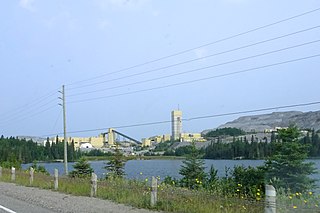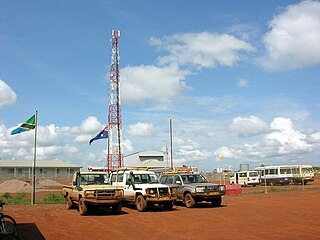
Barrick Gold Corporation is a mining company that produces gold and copper with 16 operating sites in 13 countries. It is headquartered in Toronto, Ontario, Canada. It has mining operations in Argentina, Canada, Chile, Côte d'Ivoire, Democratic Republic of the Congo, Dominican Republic, Mali, Papua New Guinea, Saudi Arabia, Tanzania, the United States and Zambia. In 2023, it produced 4.05 million ounces of gold at all-in sustaining costs of $1,335/ounce and 420 million pounds of copper at all-in sustaining costs of $3.21/pound. As of 31 December 2023, the company had 77 million ounces of proven and probable gold reserves.
Placer Dome Inc. was a large mining company specializing in gold and other precious metals, with corporate headquarters in Vancouver, British Columbia, Canada.
Newmont Corporation is an American gold mining company based in Greenwood Village, Colorado. It is the world's largest gold mining corporation. Incorporated in 1921, it owns gold mines in Nevada, Colorado, Ontario, Quebec, Mexico, the Dominican Republic, Australia, Ghana, Argentina, Peru, and Suriname. In addition to gold, Newmont mines copper, silver, zinc and lead.
Goldcorp Inc. was a gold production company headquartered in Vancouver, British Columbia, Canada. The company stood among the largest gold producers in the world, employed about 15,800 people worldwide, engaged in gold mining and related activities including exploration, extraction, processing and reclamation. Goldcorp’s operating assets included eleven mines in North and South America.

Shinyanga Region is one of Tanzania's 31 administrative regions. The region covers a land area of 18,555 km2 (7,164 sq mi). The region is comparable in size to the combined land area of the nation state of Fiji. The region is bordered to the north by the Mwanza, Mara, and Kagera Regions and to the south by the Tabora Region. In addition, the Kigoma Region borders the region to the west, and the Simiyu Region and a sliver of Singida Region to the east. The regional capital is the municipality of Shinyanga. According to the 2022 national census, the region had a population of 2,241,299.

Kahama Urban District is one of the five districts of the Shinyanga Region of Tanzania. Its administrative centre is the town of Kahama. It is bordered to the north and south by Kahama Rural District, to the east by Nzega District and to the west by Bukombe District.
John Lawson Thornton is an American businessman and professor and director of the Global Leadership Program at Tsinghua University in Beijing. He is also executive chairman of Barrick Gold Corporation, chairman of RedBird Capital Partners and non-executive chairman of PineBridge Investments. Thornton stepped down as co-president of Goldman Sachs in 2003.
The second-largest mineral industry in the world is the mineral industry of Africa, which implies large quantities of resources due to Africa being the second largest continent, with 30.37 million square kilometres of land.With a population of 1.4 billion living there, mineral exploration and production constitute significant parts of their economies for many African countries and remain keys to economic growth. Africa is richly endowed with mineral reserves and ranks first in quantity of world reserves for bauxite, cobalt, industrial diamond, phosphate rock, platinum-group metals (PGM), vermiculite, and zirconium.

China National Gold Group Corporation (中国黄金集团有限公司) is a centrally state owned Chinese gold corporation primarily engaged in the mining and refining of gold, silver, copper, and molybdenum.
The Sekenke Gold Mine was an underground gold mine in the Singida Region of Tanzania.
Tulawaka Gold Mine was a combined underground and open pit gold mine located in the Biharamulo district, in the Kagera Region of Tanzania. It is operated by African Barrick Gold, who owned 70% of the mine. The remaining 30% was owned by MDM Mines.
Bulyanhulu Gold Mine is an underground gold mine in the Shinyanga Region of Tanzania, located 55 kilometres south of Lake Victoria. It is one of three gold mines owned by Acacia Mining plc, formerly African Barrick Gold plc, a company owned by Barrick Gold, which is listed on the London Stock Exchange, and operates in Tanzania. Acacia also owns Buzwagi Gold Mine and the North Mara Gold Mine.

Buzwagi Gold Mine is an open pit gold mine in the Shinyanga Region of Tanzania, located 6 kilometres southeast from the town of Kahama. It is operated by Acacia Mining.
North Mara Gold Mine is a combined open pit and underground gold mine in the Tarime District of the Mara Region of Tanzania. It is one of three gold mines of Acacia Mining plc, a company listed on the London Stock Exchange, that operates in Tanzania, the other two being Bulyanhulu and the Buzwagi Gold Mine.
The Kirondatal Gold Mine was a gold mine in the Singida Region of Tanzania.

Kahama is a town in north-western Tanzania. The town serves as the headquarters of Kahama Urban District.

Tanzania is a land rich in minerals. Mining makes up more than 50% of the country's total exports, of which a large part comes from gold. The country has gold reserves of 10 million ounces, generating revenue of over a billion USD. Diamonds are also found in significant amounts. Since it was opened in 1940, the Williamson diamond mine has produced 19 million carats (3,800 kg) of diamonds. Gemstones, nickel, copper, uranium, kaolin, titanium, cobalt and platinum are also mined in Tanzania. Illegal mining and corruption are ongoing problems. In 2017, the government passed a series of bills aimed at increasing revenue from minerals after a scandal which caused the dismissal of the Minister for Energy and Minerals.

Msalala District is a district council in the Shinyanga Region of Tanzania's lake zone established in 2012. The district lies in the middle of the region just north-east of the town of Kahama.








